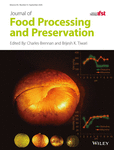Improving the resistant starch in succinate anhydride-modified cardaba banana starch: A chemometrics approach
Abstract
Resistant starch of succinate anhydride-modified cardaba banana starch was model using response surface methodology (RSM) and artificial neural network (ANN). This was investigated by varying the octenyl succinic anhydride (OSA) concentration (3%–5%), time (30–60 min), and pH (8–10) using a Box–Behnken design. According to the result, both the RSM and ANN modeling techniques predict the modification process with high accuracy (coefficient of determinant, R2 > .97 and root mean square of error =.44–.47). The optimization of the process parameters to maximize the resistant starch was performed using RSM and ANN coupled with genetic algorithm (GA). The ANN-GA gave the highest resistant starch content (39.87%) under the optimal process condition of OSA concentration 4.38%, reaction time 59.79 min, and 8.01 pH. This study revealed that the ANN-GA proved to be superior to RSM in the optimization of cardaba starch modification process.
Practical applications
In this study, the optimum starch modification conditions (succinate anhydride concentration, time, and pH) for maximizing the resistant starch in cardaba banana were investigated using response surface methodology and artificial neural network. The result obtained will enable the development of appropriate processes for starch modification from cardaba banana. It would then be possible to predict efficiently the conditions of succinate anhydride concentration, time, and pH, which will facilitate the maximization of resistant starch in the banana and increase its potential for use as a functional food ingredient in the food product development.




